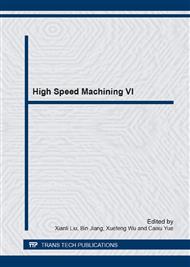p.197
p.203
p.208
p.214
p.221
p.227
p.232
p.237
p.243
Research of Dynamic Cutting Force in Hardened Steel Precision Turning Process
Abstract:
Dynamic cutting force will induce vibrations in hardened steel precision turning process. The dynamic cutting force in the process of turning was studied, and the dynamic cutting force model of hardened steel precision turning system was set; Based on DEFORM-3D software, a three-dimensional model of hardened steel turning was established by pre-set some fluctuations workpiece geometry; the turning test of hardened steel GCr15 in CAK6150DI lathe by using PCBN cutting tools, simulation and experimental results show that the high-speed precision turning will produce strip and sawtooth chip morphology; the maximum cutting force of hardened steel precision turning is the radial cutting force, which is greater than the main cutting force; cutting forces have a larger amount of fluctuation, which can reach 30% -55%. This research will provide a theoretical basis for related study on the vibration of the hardened steel turning process
Info:
Periodical:
Pages:
221-226
Citation:
Online since:
July 2014
Authors:
Price:
Сopyright:
© 2014 Trans Tech Publications Ltd. All Rights Reserved
Share:
Citation:


